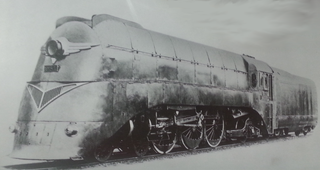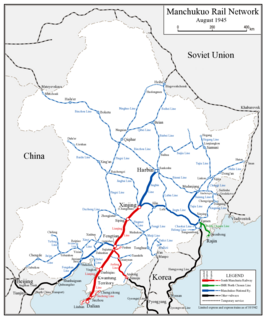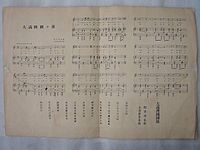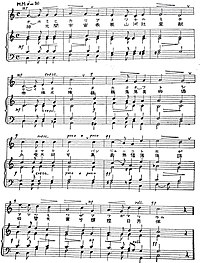
Manchukuo, officially the State of Manchuria prior to 1934 and the Empire of Manchuria after 1934, was a puppet state of the Empire of Japan in Northeast China and Inner Mongolia from 1932 until 1945. It was founded in 1932 after the Japanese invasion of Manchuria, and in 1934 it became a constitutional monarchy. Under the de facto control of Japan, it had limited international recognition.

The South Manchuria Railway, officially The South Manchuria Railway Company, Ltd., or 滿鐵 for short, was a large National Policy Company of the Empire of Japan whose primary function was the operation of railways on the Dalian–Fengtian (Mukden)–Changchun corridor in northeastern China, as well as on several branch lines.

Manchukuo was a puppet state set up by the Empire of Japan in Manchuria which existed from 1931 to 1945. The Manchukuo regime was established four months after the Japanese withdrawal from Shanghai with Puyi as the nominal but powerless head of state to add some semblance of legitimacy, as he was a former emperor and an ethnic Manchu.

Manchuria Aviation Company(traditional Chinese/Kyūjitai: 滿洲航空株式會社; simplified Chinese: 满州航空株式会社; Shinjitai: 満州航空株式会社; Hanyu Pinyin: Mǎnzhōu Hángkōng Zhūshì Huìshè; Wade–Giles: Man3-chou1 Hang2-k'ung1 Chu1-shih4 Hui4-she4 Japanese Hepburn: Manshū Kōkū Kabushiki-gaisha, "MKKK") was the national airline of Manchukuo.

The Central Bank of Manchou, was the central bank of the Japan-sponsored state of Manchukuo. The bank was established by the Bank of Manchukuo Act at Hsinking on 11 June 1932, as a joint stock company with a capital of 30,000,000 yuan, with the government holding at least 25% and at most 50% at any time. The bank officially opened its doors for business on July 1 as the amalgamation of the four note-issuing banks active in Manchuria prior to that time, namely: the Bank of the Three Eastern Provinces, the Bank of Kirin, the Bank of Heilungkiang and the Frontier Bank controlled by local warlord Chang Tso-lin. It was later revealed by audits that acquiring the four previous banks of Manchuria to be financially irresponsible as the Central Bank of Manchou held a deficit of 30,000,000 yuan in combined liabilities, but the action was deemed necessary as it was the only way to get rid of the overabundant currency issued by those banks in Manchuria in order to create a better foundation for the new Manchukuo yuan. When the Central Bank of Manchou was created it had a sufficient number of gold reserves for the new currency and paid out a dividend of 6% to investors, the stable value of the Manchukuo yuan was a major contributing factor for the development of the economy of Manchukuo.
Kō Bun'yū, also known as Huang Wenxiong, is a controversial Taiwanese author, now resident in Japan, who is well known for his staunch anti-Mainland Chinese stance and for penning a number of highly controversial books about Chinese, Japanese and Korean history and culture.

The Concordia Association was a political party in Manchukuo. Established to promote the ideals of Pan-Asianism and the creation of a multi-ethnic nation-state and to create a structure which would gradually replace military rule over Manchukuo with civilian control, the party was unable to fulfill its promise, and was eventually subverted into an instrument of totalitarian state-control by the Japanese Kwantung Army.

The Asia Express was an express passenger train operated by the South Manchuria Railway (Mantetsu) from 1934 until 1943. This limited express, which began operation in November 1934 and was Mantetsu's most iconic train, operated in Manchukuo between Dalian and Xinjing, and was extended to Harbin in 1935.

The China Railways SL7 class steam locomotive was a class of 4-6-2 express passenger steam locomotives operated by the China Railway. They were originally built for the South Manchuria Railway (Mantetsu) to pull the Asia Express - Mantetsu's signature train and most iconic locomotive, whose images were used on fliers, posters, postage stamps, and even children's school textbooks, as a symbol of technology and modernism in Manchukuo and was used to demonstrate the success of Japan's imperial project.

Lu Ronghuan, was a politician in the early Republic of China who subsequently served in a number of Cabinet posts of the Empire of Manchukuo.

Ding Jianxiu, was a politician in the early Republic of China who subsequently served in a number of Cabinet-level ministries of the Empire of Manchukuo.

The Manchukuo Government is an organisation established in 2004 in Hong Kong. On its website, it claims to be the government in exile of Manchukuo, a Japanese puppet state with limited recognition which controlled Manchuria from 1932 to 1945; it seeks to revive the state and to separate it from the People's Republic of China, which controls its claimed territory. Journalists and internet users have expressed doubts about its authenticity and aims. On its website, it claims to have merged with other Manchu independence organizations as of 2019.

The China Railways JF6 class steam locomotive was a class of 2-8-2 steam locomotives for freight trains operated by the China Railway. They were originally built in Japan and Manchukuo between 1934 and 1944 for the South Manchuria Railway (Mantetsu), the Manchukuo National Railway, and the North China Transportation Company.
The East Manchuria Railway (Japanese: 東満洲鉄道, Higashimanshū Tetsudō; Chinese: 東満洲鐵道, Dōngmǎnzhōu Tiědào; Korean: 동만주 철도 was a railway company in Manchukuo headquartered in Hunchun, Jilin Province. Its mainline ran from Hunyung in Korea on the South Manchuria Railway's North Chosen East Line to Panshi on the Manchukuo National Railway's Fenghai Line via Hunchun. From the mainline there were branchlines to Gangouzi and to Dongmiaoling.

The Manchukuo National Railway was the state-owned national railway company of Manchukuo. Generally called the "國線", it was controlled by the Manchukuo Ministry of Transportation and had its lines primarily in the central and northern parts of the country. In local newspapers it was simply referred to as "國鉄". It was built, operated and managed by the South Manchuria Railway, a state-own national railway company of the Empire of Japan, of which the Kwantung Army frequently intervened in its affairs.

The China Railways SL3 class steam locomotive was a class of 4-6-2 passenger steam locomotives operated by the China Railway. They were originally built for the South Manchuria Railway, the Manchukuo National Railway and the North China Transportation Company by several Japanese manufacturers between 1934 and 1940. They were designed in 1933 based on the design of the first Pashisa class locomotives ; the first order was placed by Mantetsu in March of that year.

The China Railways SL8 class steam locomotive was a class of 4-6-2 express passenger steam locomotives operated by the China Railway. They were originally built for the South Manchuria Railway (Mantetsu) and the Manchukuo National Railway between 1937 and 1940.
The North Chosen Line – specifically, the North Chosen West Line and the North Chosen East Line – was a railway line of the South Manchuria Railway in Japanese-occupied Korea from 1933 to 1945. Following Japan's defeat in the Pacific War and the subsequent partition of Korea, the line, being located entirely in the North, was taken over by the Korean State Railway as part of the Hambuk Line.

The Renkyō Line was the primary trunk line of the South Manchuria Railway from 1907 to 1945. The 701.4 km (435.8 mi) line ran between Dalian (Dairen) and Changchun (Xinjing).

The Manshū Nichi-Nichi Shimbun was a Japanese-language newspaper owned by the South Manchuria Railway Company and printed from 3 November 1907 until Japan's defeat in the Second World War in 1945. Printed in Dairen, capital of the Japanese-controlled Kwantung Leased Territory, and from 1938 in Mukden, it was the most influential newspaper serving the growing Japanese settler population in northeastern China. In 1927, it merged with the rival Ryōtō Shimpō and was renamed the Manshū Nippō, before returning to its original name in 1935 following another merger with Dairen Shimbun, whereupon it gained a complete monopoly on Japanese-language news in what had become the Japanese puppet state of Manchukuo. In 1944, it briefly changed its name back to Manshū Nippō before going out of print in 1945 following Japan's defeat in the war and subsequent withdrawal from Manchuria.



















